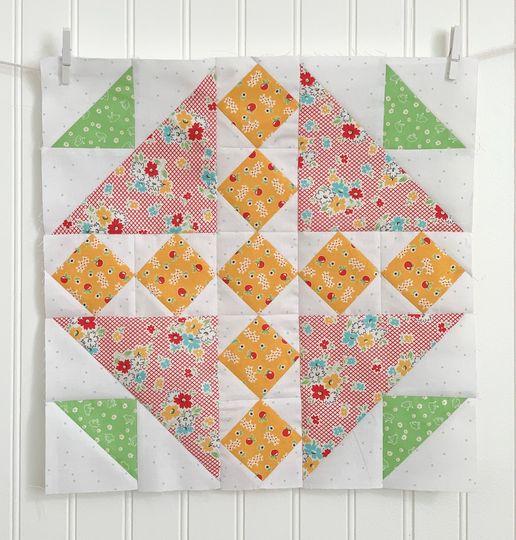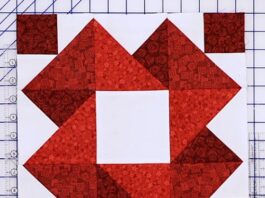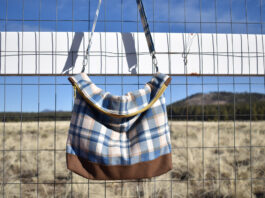If you’ve been searching for a detailed Around the Corner Quilt Block Tutorial, you’re in the right place. This guide is designed to help you master this unique quilt block, offering both beginners and experienced quilters the tools they need to create a stunning project.
The Around the Corner Quilt Block is a versatile pattern that adds a dynamic touch to any quilt, making it an excellent addition to your quilting repertoire. Whether you’re planning to use this block in a large quilt or as a standalone piece, this tutorial will guide you through each step with clarity and precision.
The Around the Corner Quilt Block is known for its crisp lines and the visual interest it creates as it “wraps around” the center of your quilt. It’s a pattern that can be as simple or as complex as you want it to be, depending on your fabric choices and the way you arrange the blocks. This tutorial will break down the process into manageable steps, ensuring that your quilt block comes together smoothly.

In this article, we’ll explore the essential aspects of creating the Around the Corner Quilt Block. From selecting your fabrics to troubleshooting common issues, every step of the process will be covered.
Additionally, we’ll offer some creative variations on the block to inspire your next quilting project. Let’s dive into this exciting tutorial and start crafting your Around the Corner Quilt Block!
1. Getting Started: Understanding the Around the Corner Quilt Block
The Around the Corner Quilt Block is a striking design that features sharp angles and a flowing movement around a central point. It’s a block that can be customized with different colors and fabrics to create a variety of looks, from traditional to modern.
What Makes This Block Special?
The unique aspect of the Around the Corner Quilt Block lies in its ability to draw the eye around the quilt. The design creates a sense of motion, guiding the viewer’s attention from one section of the quilt to another. This block is ideal for those looking to add a dynamic element to their quilting projects.
Choosing the Right Fabrics
Selecting the right fabrics is crucial for the success of your Around the Corner Quilt Block. You’ll want to choose fabrics that contrast well to emphasize the sharp lines of the design. Consider using solid colors paired with bold patterns to create a visually interesting block. The key is to ensure that the fabrics work together to highlight the “around the corner” effect.
Tools You’ll Need
Before you begin, gather all the necessary tools. You’ll need a rotary cutter, a cutting mat, a quilting ruler, and your sewing machine. These tools will help you achieve the precision required for the Around the Corner Quilt Block. Accurate cutting and consistent seam allowances are essential to ensure that your block turns out perfectly.
Cutting the Fabric
Start by cutting your fabric pieces according to the pattern you’re following. The Around the Corner Quilt Block typically requires squares and triangles that will be pieced together to create the final design. Take your time with this step, as precise cutting is critical for the success of the block.
Layout and Assembly
Once your fabric pieces are cut, lay them out to visualize the block. This step allows you to make any adjustments before sewing. Pay close attention to the arrangement of the pieces, ensuring that the colors and patterns are balanced. When you’re satisfied with the layout, begin sewing the pieces together, starting from the center and working your way out.
Pressing and Trimming
After assembling the block, press the seams flat to ensure a crisp finish. Trim any excess fabric to square up the block, making sure all edges are even. This will help when you begin to join the blocks in your final quilt assembly.
2. Step-by-Step: Assembling Your Around the Corner Quilt Block
Now that you’ve prepared your fabrics and tools, it’s time to start assembling your Around the Corner Quilt Block. Follow these steps to ensure that your block comes together beautifully.
Step 1: Preparing Your Pieces
Begin by organizing your cut fabric pieces. Lay out all the squares and triangles in the order they will be sewn. This step helps to prevent mistakes and ensures that your block will have the desired pattern and color distribution.
Step 2: Sewing the Center
Start with the center of the block, sewing the smallest pieces together. This central point is the foundation of the Around the Corner Quilt Block, so it’s essential to get it right. Make sure your seams are straight and that the fabric pieces are aligned perfectly.
Step 3: Adding the Triangles
Once the center is complete, begin adding the triangles around it. These pieces are what create the “around the corner” effect, so be precise with your seam allowances. Sew one side at a time, pressing the seams as you go to keep the block flat and manageable.
Step 4: Building the Block Outward
Continue adding the squares and triangles in layers, working from the center outwards. Each layer should wrap around the previous one, enhancing the visual effect of the block. Take your time to ensure that each piece is sewn accurately, as this will affect the overall appearance of the block.
Step 5: Final Assembly
After all the pieces have been sewn together, press the entire block to flatten it out. Check the block for any uneven edges or loose threads and make any necessary adjustments. Your Around the Corner Quilt Block should now be complete and ready to be joined with other blocks.
Step 6: Repeating the Process
If you’re making a quilt with multiple Around the Corner Quilt Blocks, repeat the process for each block. Consistency is key, so take the same care with each block to ensure they all match when assembled in the final quilt.
3. Creative Variations of the Around the Corner Quilt Block
One of the best things about the Around the Corner Quilt Block is its adaptability. Here are some creative variations you can try to make your quilt truly unique.
Variation 1: Color Blocking
Experiment with color blocking by using large sections of a single color or shade within the block. This can create a bold, modern look that draws attention to the structure of the block itself. Consider using a monochromatic color scheme for a sophisticated, cohesive design.
Variation 2: Scrappy Style
For a more eclectic quilt, try making a scrappy Around the Corner Quilt Block. Use fabric scraps from previous projects, mixing patterns and colors for a lively and vibrant effect. This variation adds character to your quilt and is a great way to use up leftover fabric.
Variation 3: Mini Blocks
Creating mini versions of the Around the Corner Quilt Block can add an intricate detail to your quilt. These smaller blocks can be used as accents or combined to create a more complex design. This variation is perfect for quilters who enjoy working on a smaller scale.
Variation 4: Inverted Design
Try inverting the design by switching the positions of the squares and triangles. This will give the block a new look and can be used to create interesting patterns when the blocks are joined together in the final quilt. It’s a subtle change that can have a big impact on the overall design.
Variation 5: Using Prints and Solids
Mixing printed fabrics with solid colors can highlight different aspects of the Around the Corner Quilt Block. Use prints for the larger sections and solids for the smaller ones to create a balanced and visually appealing design. This variation allows you to play with texture and pattern in your quilt.
Variation 6: Gradient Effect
Create a gradient effect by using fabrics that gradually change in color from light to dark. Arrange these fabrics so that the color transitions smoothly across the block, creating a beautiful ombre effect. This variation adds depth and dimension to your quilt, making it visually striking.
4. Troubleshooting Common Issues with the Around the Corner Quilt Block
Even with careful planning, you may encounter some challenges while making your Around the Corner Quilt Block. Here are some common issues and how to solve them.
Issue 1: Uneven Seams
Uneven seams can cause the block to look crooked or misaligned. To avoid this, use a consistent seam allowance and double-check your measurements before sewing. If you notice uneven seams after sewing, try pressing the block to flatten it or resewing the affected areas.
Issue 2: Fabric Stretching
Fabric stretching can occur if you’re not careful while cutting or sewing. To prevent this, use a sharp rotary cutter and handle the fabric gently. If stretching does occur, try to ease the fabric back into shape while sewing.
Issue 3: Misaligned Pieces
If the pieces aren’t aligning correctly, it could be due to inaccurate cutting or sewing. Re-check your measurements and make sure you’re using the correct seam allowance. If necessary, trim the pieces slightly to ensure they fit together properly.
Issue 4: Difficulty with Small Pieces
Working with small pieces can be challenging, especially for beginners. If you find this difficult, consider starting with a larger block size and gradually working your way down to smaller pieces as you gain confidence.
Issue 5: Block Not Squaring Up
If your block isn’t squaring up, it could be due to inconsistencies in your seam allowances or cutting. Use a square ruler to check the dimensions of your block and trim any excess fabric to ensure it’s even.
Issue 6: Color Bleeding
Color bleeding can happen if the fabrics aren’t pre-washed. To avoid this, always pre-wash your fabrics before starting your quilt. If bleeding does occur, you can try washing the block with a color catcher to absorb excess dye.
FAQ: Frequently Asked Questions
1. What fabrics work best for the Around the Corner Quilt Block?
The best fabrics for the Around the Corner Quilt Block are those with a good contrast between colors. Solid colors and bold prints work well, as they highlight the sharp lines of the design.
2. Can I make an Around the Corner Quilt Block by hand?
Yes, you can make an Around the Corner Quilt Block by hand. While using a sewing machine is faster, hand-sewing allows for greater precision and control, especially for beginners.
3. How can I ensure my blocks are all the same size?
To ensure consistency, use a ruler to measure and trim each block after sewing. Also, make sure your seam allowances are consistent throughout the process.
4. What size should I make my Around the Corner Quilt Block?
The size of your Around the Corner Quilt Block can vary depending on your project. Common sizes range from 6 to 12 inches, but you can adjust according to your preference.
5. Can beginners make the Around the Corner Quilt Block?
Yes, beginners can make the Around the Corner Quilt Block. Start with a simpler version of the block, using larger pieces, before moving on to more complex designs.
6. How do I avoid puckering in my quilt block?
To avoid puckering, make sure to press your seams as you go and avoid stretching the fabric while sewing. Using a walking foot on your sewing machine can also help.
Join our VIP broadcast list and gain access to exclusive patterns, all for free. As a VIP member, you’ll receive the best patterns daily, delivered directly to your device. ✨📱 It’s a unique opportunity to stay up-to-date with the latest trends and designs, curated just for you. Don’t miss out on enhancing your projects and discovering new inspirations with the best patterns every day! 🎨🔝
Conclusion
The Around the Corner Quilt Block Tutorial has provided you with the essential steps and tips to create a beautiful and dynamic quilt block. Whether you’re a beginner or an experienced quilter, this block offers endless possibilities for creativity and customization. By following the steps outlined in this tutorial, you can confidently create a quilt that showcases the unique “around the corner” design.
We hope this tutorial has been helpful and inspiring. If you enjoyed this article, please share your thoughts and suggestions in the comments below. Happy quilting!



